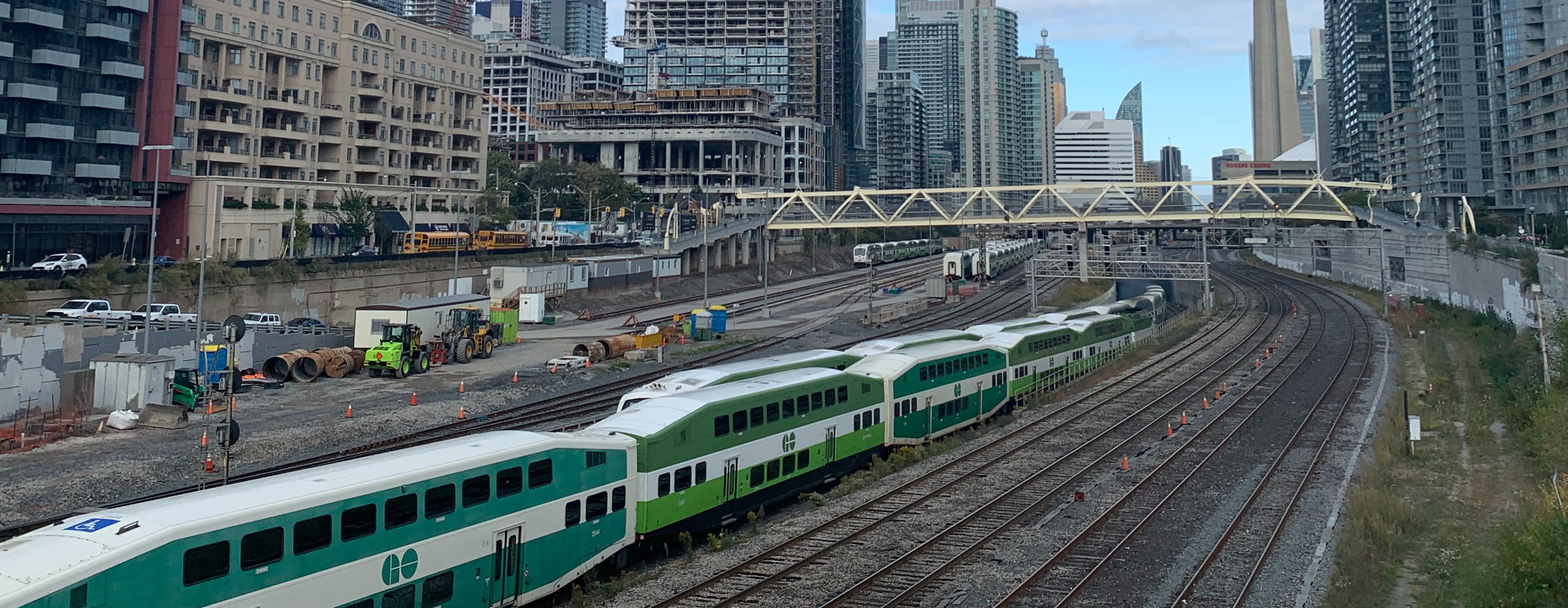GO Expansion in Toronto with means new lines and new stations
GO Expansion will deliver all-day, two-way service with faster trains running every 15 minutes.
Nov 22, 2021
A new era in public transit for Toronto is about to begin.
New lines inside the city are getting most of the attention. The Eglinton Crosstown, Finch West LRT and four new subway projects – as well as SmartTrack stations – will be important additions to the transit map.
These new projects are not standalone improvements, they are all part of a plan to build an integrated network delivering seamless transit connections.
New additions are not the only improvements.
GO Expansion will deliver a dramatic increase in service along the existing rail lines. More frequent trains will improve service for suburban commuters coming into downtown Toronto – and they will make GO a more attractive option for trips starting in The Six.
The April 2019 decision to reduce fares for shorter trips provided a new incentive to take GO trips inside Toronto. GO Expansion will be another step.
Passengers will benefit from more all-day service, trips in both directions in and out of Toronto, departures every 15 minutes and faster electric trains.
“Electric trains can travel up to 30 per cent faster and they can run more frequently,” said Kelly Hagan, Metrolinx vice president of community engagement for Toronto. “With 15-minute service you won’t need access to a schedule.”
Newer model GO train locomotives sit ready to go at Oshawa GO Station. (Mike Winterburn photo)
More frequent service will make GO more like the subway – a benefit for both suburban commuters and Toronto residents.
“Does anybody ever look at a subway schedule before they go and walk to the subway?” she asked rhetorically. “No, you just go to the station and expect to be able to go where you want to go.”
Metrolinx is not just making GO more like subway service, it is also delivering four new subway projects – the Ontario Line, Yonge North Subway Extension, Scarborough Subway Extension and Eglington Crosstown West Extension.
The new subways lines were mapped out to maximize connections with other forms of transit.
For example, the Ontario Line will connect to TTC Lines 1 and 2, the new Eglinton Crosstown LRT and existing surface routes. At the new East Harbour GO Station, by the Don River, and the existing Exhibition GO, the Ontario Line will offer GO riders new subway transfer points, allowing them to bypass Union Station, reducing crowding there.
New lines with easy connections that help riders get where they need to go faster will create a network effect and encourage more people to take transit.
SmartTrack is another new project designed to offer convenient connections to help people move around Toronto.
Five new GO stations – Finch-Kennedy, East Harbour, King-Liberty, Bloor-Lansdowne, and St. Clair-Old Weston – will be placed along existing GO tracks.
The future King-Liberty GO Station will bring a new transit option to a densely populated section of Toronto. This is an artist’s rendering and final designs are subject to change. (Metrolinx photo).
“What’s unique about SmartTrack is that it’s taking what has been looked at for years as a suburban commuter network and strategically bringing new neighbourhood GO stations into high density areas of Toronto where people will be able to make meaningful connections with the TTC,” said Marcia Medrano, vice president of GO Expansion stations capital delivery at Metrolinx.
Transfers to TTC routes will ensure the benefits go beyond those who can walk or bicycle to the stations.
“The stations are being designed to fully integrate with the TTC network, whether that be by bus, subway, or streetcar, creating a mesh to maximize what’s already there,” said Nadine Navarro, vice president and head sponsor for stations at Metrolinx.
For example, SmartTrack will provide a North-South connection to streetcars along the western end of St. Clair Avenue and the Bloor-Danforth subway at Lansdowne, giving people new, time-saving travel options.
New GO stations are also coming to other places along the network.
For example, in the Mount Dennis community, a new GO station will connect Kitchener Line customers to midtown destinations on the Eglinton Crosstown LRT. Caledonia GO will do the same for customers on the Barrie Line.
The Mount Dennis GO Station will offer connections to the Eglinton Crosstown LRT, from the restored Kodak building, which was originally constructed in the late 1930s. (Metrolinx photo)
As well, Kennedy GO will become a hub offering a new connection to the Eglinton Crosstown LRT, in addition to current TTC links.
With more service including evenings and weekends, GO stations will connect residents to weekend destinations outside of the city. In fact, GO service will quadruple from 1,500 trips per week to 6,000.
GO Expansion will also include more trips in both directions, making it possible for people to take morning rush hour trains out of Toronto to growing employment centres outside the city, like the tech cluster in Kitchener-Waterloo.
This all part of an ambitious plan with a simple goal.
“Transforming transit means making it easier for customers to connect and get where they need to go,” Hagan said.
by Mike Winterburn Metrolinx communications senior advisor
